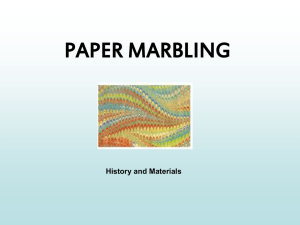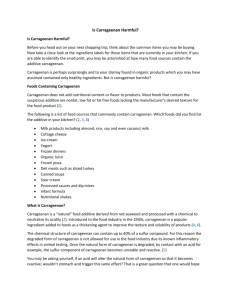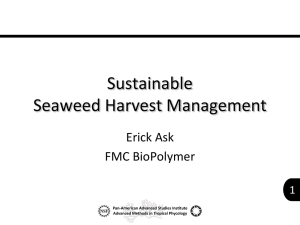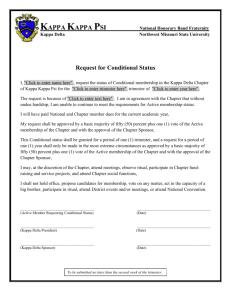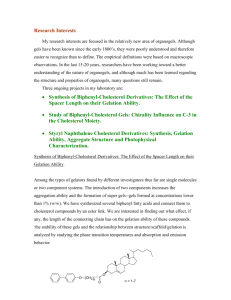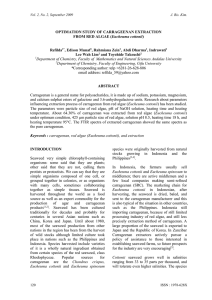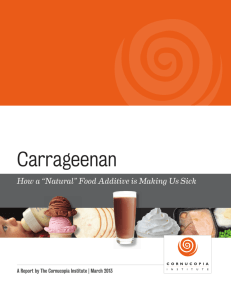Production and Food Applications of Carminic Acid
advertisement
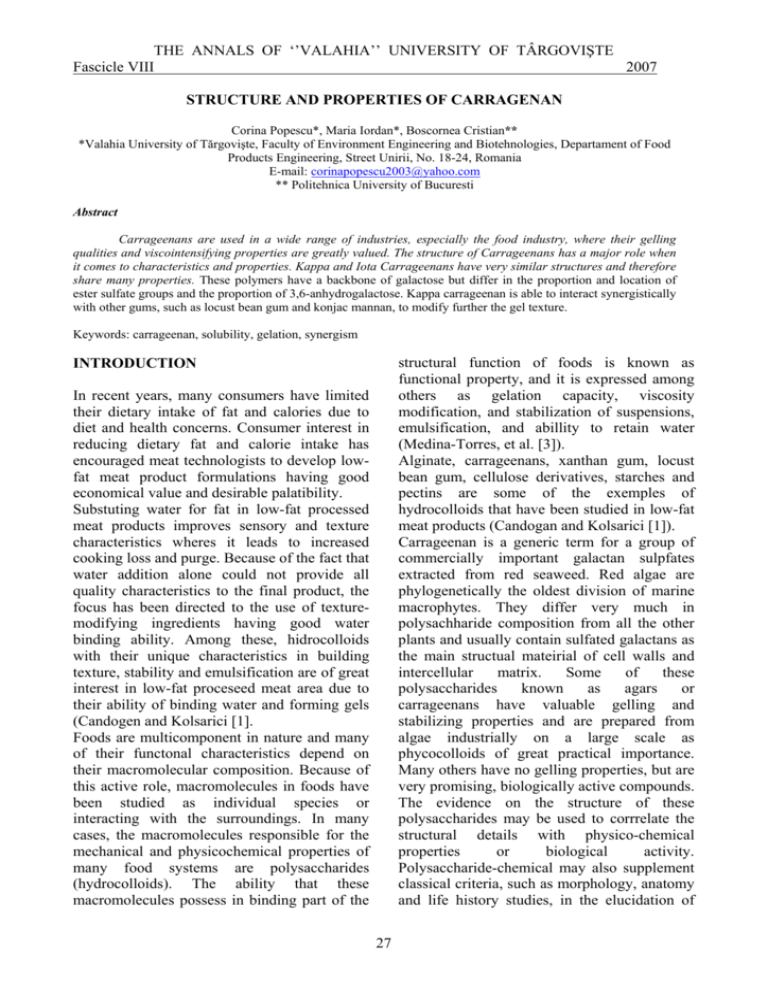
THE ANNALS OF ‘’VALAHIA’’ UNIVERSITY OF TÂRGOVIŞTE Fascicle VIII 2007 STRUCTURE AND PROPERTIES OF CARRAGENAN Corina Popescu*, Maria Iordan*, Boscornea Cristian** *Valahia University of Tărgovişte, Faculty of Environment Engineering and Biotehnologies, Departament of Food Products Engineering, Street Unirii, No. 18-24, Romania E-mail: corinapopescu2003@yahoo.com ** Politehnica University of Bucuresti Abstract Carrageenans are used in a wide range of industries, especially the food industry, where their gelling qualities and viscointensifying properties are greatly valued. The structure of Carrageenans has a major role when it comes to characteristics and properties. Kappa and Iota Carrageenans have very similar structures and therefore share many properties. These polymers have a backbone of galactose but differ in the proportion and location of ester sulfate groups and the proportion of 3,6-anhydrogalactose. Kappa carrageenan is able to interact synergistically with other gums, such as locust bean gum and konjac mannan, to modify further the gel texture. Keywords: carrageenan, solubility, gelation, synergism structural function of foods is known as functional property, and it is expressed among others as gelation capacity, viscosity modification, and stabilization of suspensions, emulsification, and abillity to retain water (Medina-Torres, et al. [3]). Alginate, carrageenans, xanthan gum, locust bean gum, cellulose derivatives, starches and pectins are some of the exemples of hydrocolloids that have been studied in low-fat meat products (Candogan and Kolsarici [1]). Carrageenan is a generic term for a group of commercially important galactan sulpfates extracted from red seaweed. Red algae are phylogenetically the oldest division of marine macrophytes. They differ very much in polysachharide composition from all the other plants and usually contain sulfated galactans as the main structual mateirial of cell walls and intercellular matrix. Some of these polysaccharides known as agars or carrageenans have valuable gelling and stabilizing properties and are prepared from algae industrially on a large scale as phycocolloids of great practical importance. Many others have no gelling properties, but are very promising, biologically active compounds. The evidence on the structure of these polysaccharides may be used to corrrelate the structural details with physico-chemical properties or biological activity. Polysaccharide-chemical may also supplement classical criteria, such as morphology, anatomy and life history studies, in the elucidation of INTRODUCTION In recent years, many consumers have limited their dietary intake of fat and calories due to diet and health concerns. Consumer interest in reducing dietary fat and calorie intake has encouraged meat technologists to develop lowfat meat product formulations having good economical value and desirable palatibility. Substuting water for fat in low-fat processed meat products improves sensory and texture characteristics wheres it leads to increased cooking loss and purge. Because of the fact that water addition alone could not provide all quality characteristics to the final product, the focus has been directed to the use of texturemodifying ingredients having good water binding ability. Among these, hidrocolloids with their unique characteristics in building texture, stability and emulsification are of great interest in low-fat proceseed meat area due to their ability of binding water and forming gels (Candogen and Kolsarici [1]. Foods are multicomponent in nature and many of their functonal characteristics depend on their macromolecular composition. Because of this active role, macromolecules in foods have been studied as individual species or interacting with the surroundings. In many cases, the macromolecules responsible for the mechanical and physicochemical properties of many food systems are polysaccharides (hydrocolloids). The ability that these macromolecules possess in binding part of the 27 THE ANNALS OF ‘’VALAHIA’’ UNIVERSITY OF TÂRGOVIŞTE Fascicle VIII 2007 intensive as the seaweed is collected by raking or hand-gathering, mechanical harvesters have been tested but have shown little to no improvement in yield. The seaweed is then washed to remove sand, stones and other impurities. Then the seaweed is taken to the production plant and extracted under alkaline conditions to produce quality carrageenans. This lasts several hours at temperatures close to the boiling point of the alkaline solution. The extract is then filtered and concentrated to a final carrageenan concentration of 3%. It is then precipitated by the addition of 2propanol, dried, and ground to the desired particle size. Often additives are blended into the final product, such as sucrose and glucose, to increase viscosity or gelling properties. The major device that affects the gelling properties of the final carrageenan product is alkali used and time of extraction used (Lamond [9]). taxonomic position of several red algae (Usov [6]). Carrageeenans are extensively, gel or texture enhancers, stabilisers, etc. These additives give textural properties and protective effects to a wide range of products such as frozen desserts, chocolate, cottage chesse, whipped cream, instant breakfasts, yoghurt, jellies, pet foods, relishes, sauces and syrups (Tojo end Prado [5]). Source. The term “carrageenan ” describes a class of sulphated galactan poliyaccharides that occur as cell wall constituents in numerous species of red seaweed (marine algae of the class Condrus crispus found on the coasts of Irland, England and Spain, Eucheuma species near the Philippines, Rhodophyceae) (carbohidrates [10]). k-Carrageenan is predominantly obtained by extraction of the tropicalseaweed Kappaphycus alvarezii, known in trade as Eucheuma cottonii (or simply cottonii). Eucheuma denticulatum (trade name Eucheuma spinosum or simply spinosum) is the main species for the production of ι-carrageenan. λ-Carrageenan is obtained from diffrent species from the Gigartina and Chondrus genera. The sporophytic plants of these seaweeds produce λ-carrageenan whereas the gametophytic plants produce a k/ι-hibrid type of carrageenan. These k/ι-hibridcarrageenans consist of a mixed chani containing both k-and ι-units and range from almost pure ι-carrageenan to almost pure kcarrageenan. The production of λ-carrageenan implies the selection of samples in the sporophyte stage while the extraction can be carried out with hot water as the cyclization, in alkaline medium,. to θ-carrageenan is difficult and this product has essentially the same properties as λ-carrageenan (F.van de Velde, et al. [2]). Structures. Structure of carrageenans are a family of water soluble, linear, sulfated galactans. The backbone of the polysaccharide is formed of D-galactose units linked alternately with α-(1-3) anb β- (1-4) linkages. The carrageenans are clasified according to the presence of 3,6-anhidro-D-galactose on the 1,4linked residue and the position and number of sulpfated groups (fig. 1). Greek letters have been assigned to varions ”idealised” disaccharide repeating unites. However, natural carrageenans containining only one type of repeating disaccharide may not exist but consist of molecular hybrids of two or more idealised structures. The properties of such hybrids depend very much on the distribution of the different disaccharide unites along the polymeric chain. The three principal types of industrial importance are kappa, iota and lambda carrageenans. Kappa (k) and iota (i) forms are gelling polymers, white lambda (λ) is a nongelling, thickening agent (Tojo and Prado [5]). Manufacturin. There are many different methods used to extract Carrageenans from seaweed and processing conditions are usually considered trade secrets by the manufactures as these produce the variables in the Carrageenan properties. Firstly the Carrageenan-containing seaweeds are harvested which is labour Solubility. All carrageenan are soluble in hot water. Sodium salts of both kappa and iota carrageenans are soluble in cold water. potassium and calcium salts do not dissolve; however, they exhibit the ability to swell. 28 THE ANNALS OF ‘’VALAHIA’’ UNIVERSITY OF TÂRGOVIŞTE Fascicle VIII 2007 Swelling is variable and is dependent upon the particle density. iota carrageenan is sensitive to calcium ions and it will swell to form thixotropy results from the formation of bivalent calcium bridges between the swollen particles to form a losse 3- Dimensional network (Budnis [7]). The influence of temperature is an important factor in deciding which carrageenan should be used in a food system. All carrageenans hydrate at high temperatures and kappa and iota carrageenans in particular exhibit a low fluid viscosity. On cooling, these carrageenans set between 40–60ºC, depending on the cations present, to form a range of gel textures (Imeson [8]). double helices then must aggregate to form a 3dimensional network. A general mechanism of gelation is shown in Figure 2. The mechanism indicates that both kappa and iota gels are thermoreversible gels. The gels will become fluid when heated above their melting temperature and will reset upon cooling with minimal to no loss of their original gel strength (Budnis [7]). The gelation mechanism is controversial, and the domain model has been suggested to explain gelation in terms of coil-to helix transition followed by aggregation of domains of double helices in the presence of gelinducing ions. The i-carrageenan displays a greater hydrophilic character than the kcarrageenan because of the presence of additional sulphate grout in the anhydrons galactose residue. This also enhances its ability to inhibit syneresis, even though its gels are less rigid than those of k-carrageenan owing to its lower aggregation capacity (Medina-Torres [3]). Figure 2.Thermoreversibility of Carrageenan gels (Lamond, 2004) Figure 1. Structures of kappa, lambda and iota carrageenan Hot solutions of kappa and iota carrageenans set to form a range of gel textures when cooled to between 40 and 60ºC depending on the cations present. Carrageenan gels are thermally reversible and exhibit hysteresis or a difference between setting and melting temperatures. These gels are stable at room temperature but can be remelted by heating to 5–20ºC above Carrageenan gelation mechanism. Kappa and iota are gelling carrageenans. In order for gelation to occur, the helix of a single carrageenan molecule must come in close proximity to a second identical single carrageenan helix to form a duble helix. The 29 THE ANNALS OF ‘’VALAHIA’’ UNIVERSITY OF TÂRGOVIŞTE Fascicle VIII 2007 and types of carrageenan suitable to such food applications (Budnis [7]). the gelling temperature. On cooling the system will re-gel. The ionic composition of a food system is important for effective utilisation of the carrageenan. For example, kappa carrageenan selects for potassium ions to stabilise the junction zones within the characteristically firm, brittle gel as shown in Fig. 3 (a). Iota carrageenan selects for calcium ions to bridge between adjacent chains to give typically soft elastic gels in Fig. 3(b). The presence of these ions also has a dramatic effect on the hydration temperature of the carrageenan and on its subsequent setting and remelting temperatures. For example, iota carrageenan will hydrate at ambient temperature in water but the addition of salt raises the gel point so that the solution is converted into a gel with distinct yield point which is used for cold-prepared salad dressings. Sodium salts of kappa carrageenan will hydrate at 40ºC but the same carrageenan in a meat brine will only show full hydration at 55ºC or above. Gelation of kappa and iota carrageenans with cations (fig. 3). As a carrageenan dispersion is heated there is no significant particle swelling or hydration until the temperature exceeds about 40–60ºC. As the particles hydrate the viscosity rises as the swollen particles offer more resistance to flow. Further heating to 75–80ºC produces a drop in viscosity. On cooling, the solution shows a marked increase in viscosity followed by gelation below temperatures of 40–50ºC. The hydration and gelation temperatures are strongly dependent on the salts associated with the carrageenan or added separately to the solution. For example, levels above about 4% sodium chloride can prevent full hydration of carrageenan in meat products. In contrast, the very dilute levels of around 200ppm of carrageenan used to stabilise chocolate milks and other dairy beverages may not form a stabilising gel network until the temperature drops below 20ºC. The presence of high solids, such as in confectionery, effectively concentrates the carrageenan and cations on the aqueous phase so the gelation may occur at 80– 85ºC or higher placing limitations on the levels Synergism whith other gums. Kappa carrageenan is synergistic with locust bean gum and konjak mannan. Hot solutions of kappa carrageenn-locust bean gum strong elastic gels with low syneresis when cooled below 50-600C. Locust bean gum is a galactomannan with a level of substitution of one part mannose to four units of galactose. However, this substitution is not regular and regions of the locust bean gum are unsubstituted. The mannose-free regions of the locust bean gum are able to associate whith the repeating helicalstructure of regions of the locust bean gum are able to associate with the repeating helical structure of carrageenan dimers to form gels. The maximum interaction and hence pik rupture gel strongth, occurs at a rations betwen 60:40 and 40:60 kappa carrageenan to locust bean gum. These polymer combinations are used in very large quantities in cooked meats and in gelled petfoods (Imeson [8]). These synergistic interactions enhance the gel strength and water binding capabilities, as well as modify the gel texture to be more elastic and resilient (Budnis ). 30 THE ANNALS OF ‘’VALAHIA’’ UNIVERSITY OF TÂRGOVIŞTE Fascicle VIII 2007 with characteristic structural elements can be obtained in reasonable high quantities. On the other hand molecules enriched with uncommon irregularities or non carrageenan constituents might be retained and subsequently isolated by a proper fragtionation technique (see below). In this way, cryptic structures, that otherwise would be masked below the noise level in the 13 C-NMR spectra can be identified. Carrageenases are endo-β-galactanases, cleaving the internal β-(1→4) linkages with sulfate substitution pattern related specificity. Oligosaccharides of the neocarrabiose are the main products from molecules or molecular regions that possess structurall regularities of a certain length. By far the most popular enzyme is k-carrageenase, which might be obteained from several bacteria. it has successfully ben produced in a stable form by large-scale fermentation of Pseudomonas carragenovora on k-carrageenan from Kappaphycus alvarezii. In general it has been quie well established among researchers that stable enzyme have successfully been prepared by cloning in E. coli, giving more stable enzymes, especially important for ι-carrageenanse. Unfortunately at the moment carrageenases are not commercially available for routine structure analysis (F. van de Velde, et al. [2]). a) Mechanism gelation of K-carrageenan b) Mechanism gelation of iota-carrageenan Figure 3. Gelation of kappa and iota carrageenans with cations (Budnis [7]) Protein Reactivity. All carrageenans are known to be protein reactive. Reactivity is a function of the isoelectric point (pI) of protein, the pH of system, the weight ratio protein to carrageenan, the type of protein, and the molecular weight. The interaction between proteins and carrageenan occur by a combination of twe mechanisms. The mechanisms are divalent bridging and ionic bonding. Above the pI of the protein, the carboxylic acid groups of the protein will be ionized; therefore, the carrageenan does not interact with the protein due to negativenegative repulsions (Budnis [7]). REFERENCES Journals: [1] [2] Enzymatic depolymerisation. As for polysaccharides in general, the use of specific enzymes is an ultimate tool for structural analysis of carrageenans. By selecting a suitable enzyme, well-defined oligosaccharides [3] 31 Candogean, K. and Kolsarici, N. The effects of carrageenan and pectin on some quality characteristics of low-fat beef frankfurters. Meat Schience 2003, 64, 199-206. F. van de Velde, Knutsen, S. h., Usov, A.I., Rollema, H.S. and Cerezo, A.S. 1H 13 and C high resolution NHR spectroscopy of carrageenans: application in reserch and industry. Food Schience & Technoligy 2002, 13, 73-92. Medina-Torres, L., Brito-De La Fuente, E., Torrestiana- Sanchez, B., Alonso, S. Mechanical properties of gels formed by THE ANNALS OF ‘’VALAHIA’’ UNIVERSITY OF TÂRGOVIŞTE Fascicle VIII 2007 [4] [5] [6] mixtures of mucilage gum (Opuntia ficus indica) and carrageenans. Carbohydrate Polymer 2003, 52, 143-150. Tojo, E. and Prado, J. Chemical composition of carrageenan blends determined by IR spectroscopy combined with a PLS multivariate calibration method. Carbohydrate Reserch 2003, 00, 1-4. Tojo, E. and Prado, J. A simple 1H NMR method for the quantification of carrageenans in blend. Carbohydrate Polymers, 2003, 1-5. Usov, A.I. Structural analysis of red seaweed galactans of agar and carrageenan groups. Food Hydrocolloids, 1998, 12, 301-308. Books: [7] Budnis, W. Carrageenan. FMC BioPolymer, 2000, section 13, 1-34. [8] Imeson, A.P. Carrageenan. FMC Corporation (UK) Ltd, 5, 88-102. [9] Lamond, T., Characterization of Seaweed derived carrageenans. CHEE 4006, 2004., 1-55. Refernces sourrced via the worldwidw web: [10] www.carbohidrates.htm 32

